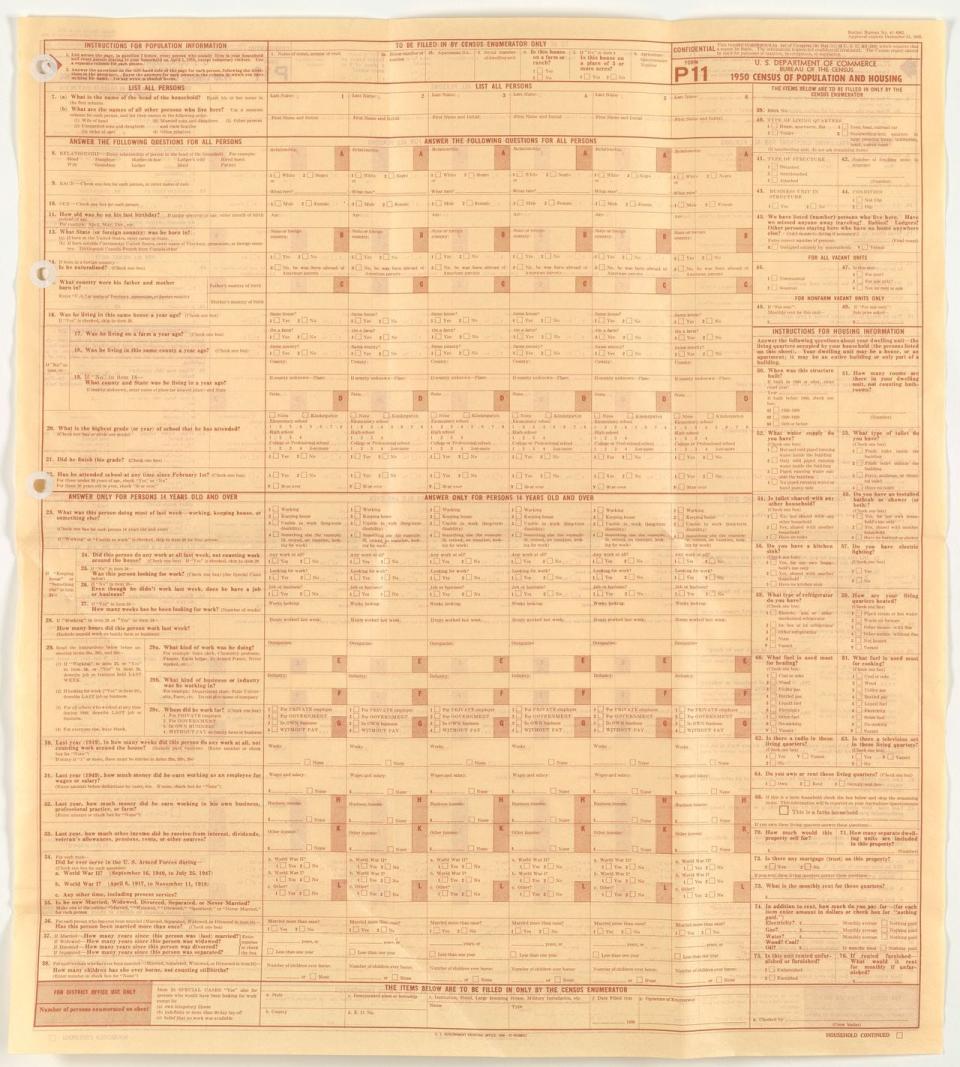After a mandatory 72-year wait, 1950's detailed U.S. census data will be released Friday
Historians and genealogists rejoice. On Friday, the 1950 U.S. Census individual-level data will be released to the public.
Sequestered by law for 72 years, the personally identifiable and detailed data from the mid-century census will be posted on a new website recreated by the National Archives and Records Administration. The digitized records from population schedules to enumeration district maps will be free to access.
The 1950 data provides an insight into a population on the brink of transformation, said Marc Perry, a senior demographer for the U.S. Census Bureau who called the data set a "genealogy gold mine."
For privacy reasons, access to "personally identifiable information contained in decennial census records is restricted to all but the individual named on the record or their legal heir for 72 years," according to the National Archives. The 2020 (2021) census data won't be released until 2092.
So, why 72 years? According to the Pew Research Center, the most common explanation is that 72 years was the average lifespan at the time the law was established.
Because of the restriction on access to the records, 1940 is the most recent census year currently available.

The data from the 1940 census shows 132.2 million Americans were counted in 1940. Almost 90% of the counted were white. There was no "Hispanics" category in 1940, according to the Pew Research Center. That was added to the forms in 1980. In 1940, at least a quarter of those 25 years or older had at least a high school diploma, the Pew center shows. That number stands at 86% today.
Collectively, the demographic snapshots of individuals and households show the population in 1950, the 17th decennial census, looked more like it did in 1940 than it would reflect that of 1960, Perry said. Advances in technology, transportation and suburbia awaited.
"The country had not yet been impacted by most of those major post-war demographic and economic trends that would greatly change the size, shape and the composition of the U.S. population," Perry said.
Taxes: Almost half of NJ families haven't claimed a child tax credit, and time is running out
The information in the 1950 census stems from 38 questions. Some of those questions, 12 fewer than asked in 1940, today may seem odd. Among them: Do you have a kitchen sink, and is there a television set in your living quarters? Enumerators also asked what type of toilet and refrigerator you used.
Those questions nonetheless share an interesting story about American society at the time and the foundations that were being laid for future trends.
A preliminary assessment showed an outsized number of marriages and young families in smaller households, Perry said.
For the first time, more than half of all homes were owner-occupied, said Sharon Tosi Lacey, the chief historian for the U.S. Census Bureau.
Data that will be accessible as of April 1 includes roughly 6.6 million digital images, including forms from Native American reservations and overseas military bases.
Census: 2020 Census undercounted Latinos, Native Americans and Black Americans at high rates
Names and addresses of heads of household will also be available, but the data will be sorted by state, county and enumeration district. With about 230,000 districts in 1950, that could pose issues, Census Bureau officials said. However, there are search tools available, including one kept by Stephen Morse at stevemorse.org, to match state, county, street address and district. Officials at the National Archives are also working with Amazon Web Services to develop a name and location index. More information is at archives.gov.
The Bureau during the 1950 collection period marked other firsts, Lacey said. Forms were used in newspapers and enumerators went out at night to count transient populations at hotels and shelters. College students were counted at their dorms for the first time.
Story continues below 2020 Census map.
"We started making greater efforts to count missed people," she said.
Computers were also first used during the 1950 census. Following that census, the bureau conducted its first post-enumeration survey to check its work for accuracy. Among its findings: about two-thirds of men and women were married, less than three-tenths of women worked and fewer than one in 10 people lived alone.
The New Jersey population, in 1950 was 4.872 million, in 2020 it was 9.289 million.
The 72-year wait for the data's release was codified by Congress in 1978 for all U.S. Census records, including those collected in 2020. Before then, the policy was a result of a 1952 agreement between the Census Bureau and National Archives. It came on the heels of the 1950 Federal Records Act meant to regulate the archiving and disposal of government information.
The U.S. Census Bureau conducts a census every 10 years to determine the number of people in the United States. The data collected are used to apportion the number of seats each state has in the U.S. House of Representatives, according to the United States Census Bureau. The first census was in 1790 during President George Washington's first term. Secretary of State Thomas Jefferson is responsible for the effort. That first census found 3,929,625 lived in the United States. Congress used the results to apportion 105 seats among 15 states.
David Zimmer is a local reporter for NorthJersey.com. For unlimited access to the most important news from your local community, please subscribe or activate your digital account today.
This article originally appeared on NorthJersey.com: 1950 census release: Data revealed Friday after 72-year wait

